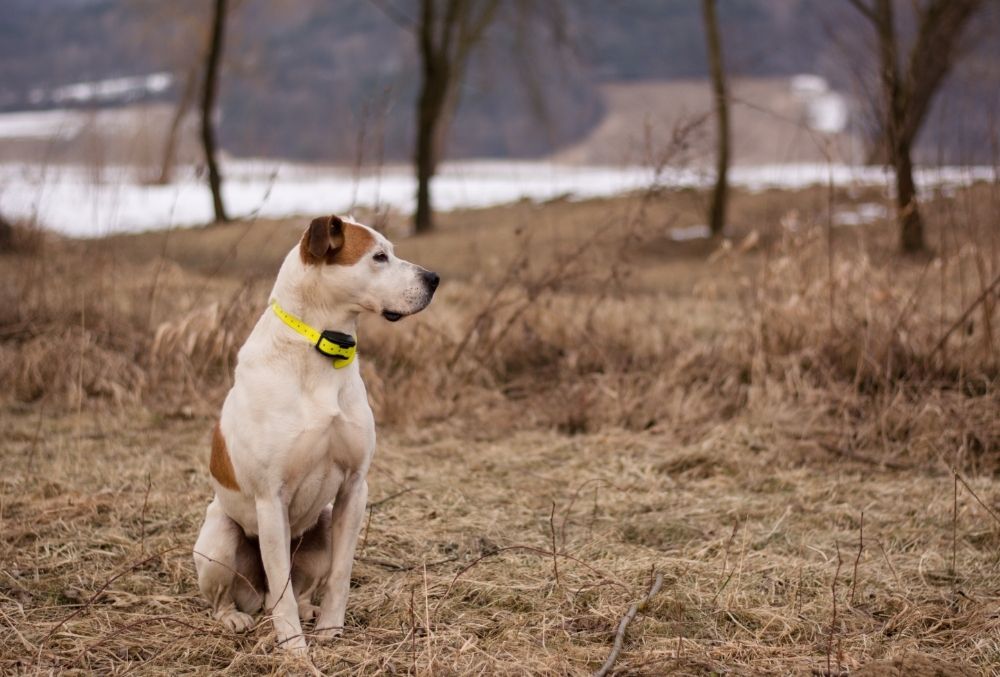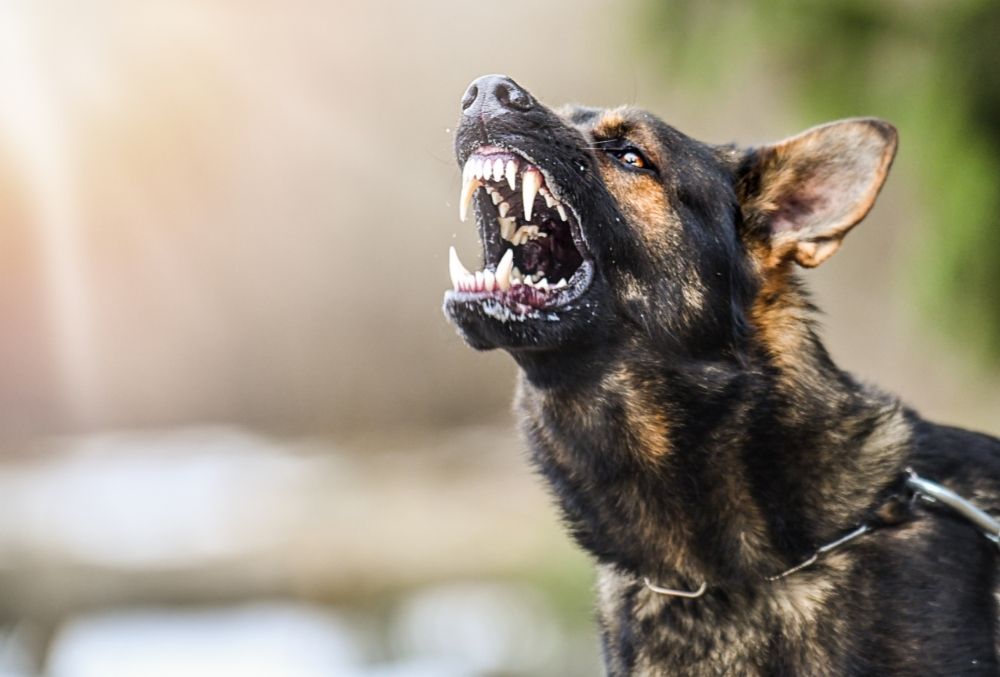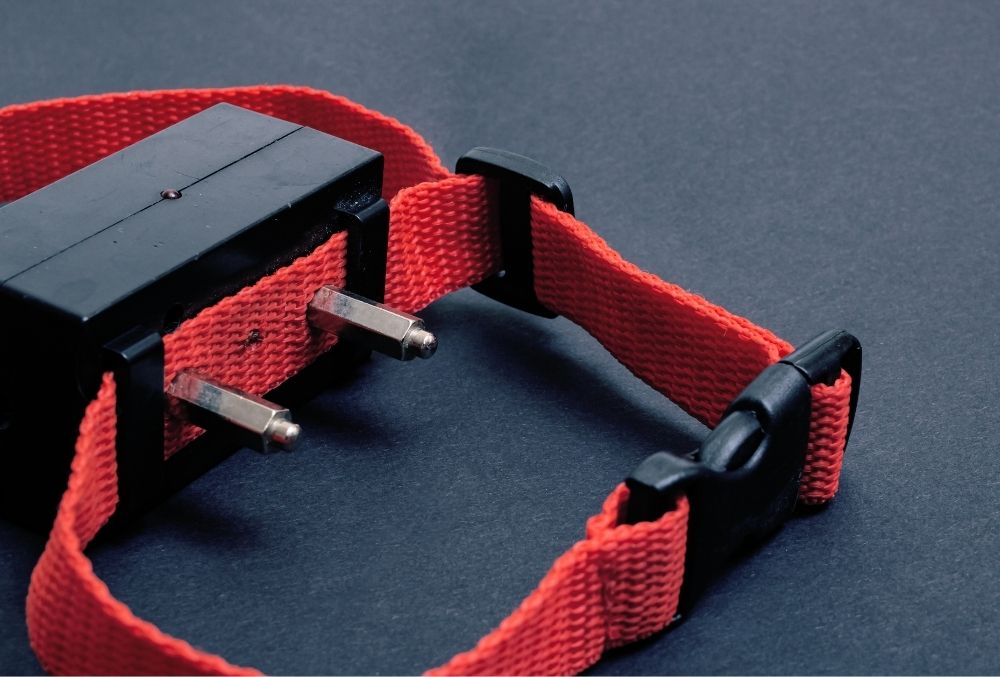This post may contain affiliate links. Please read my disclaimer policy
Are you in the process of obedience training your dog, or perhaps you have seen undesirable behavior in your canine companion?
Regardless of why you are considering a shock collar, you must want to know if there are any adverse side effects. On top of that list is aggression, will a shock collar make your dog more aggressive?
In this article, we are going to look at this question in detail and find out what exactly a shock collar does to your canine friend and if they do indeed cause aggression.
Contents
Shock Collars in General
The shock collar got its start in life in the 1960s and was specially created to help train hunting dogs. Today, they are used by pet owners when they are in the process of obedience training or as a way to alter an undesirable behavioral trait that has been developed.

These collars have been used for pet containment or as a way to deter thieves. This is because of the tracking device that is often a part of these collars. Service dogs in the military or police are regularly trained using shock collars, which has been shown to be effective in the past.
The Different Uses for a Shock Collar
If you have found that shock collars are something that you agree with, there are many ways you can use them while training your dog. One of the things that can be corrected with the help of a shock collar is undesirable behavior, such as:
- Chewing items that are not allowed or destructive chewing.
- Jumping up on guests that enter your home.
- Barking can be controlled by using a shock collar.
- Chasing people, animals, or things that you do not want them to.
- Digging in your garden or out on walks.
- Eating things that they are not allowed to eat.
- Jumping on furniture that they are not allowed on.
In addition to correcting undesired behavior, you can also use a shock collar to help in training. Sitting, heel, come, or even down are some examples of simple commands you can improve while using a shock collar.
A lot of people think that these collars are supposed to be used outdoors only, but if you really want to, you can use them in your own home as part of your training regime.
The use of remote-controlled shock collars is also a great help in certain training situations. You can use them to curb bad behavior, so the shock can be a form of punishment.
If you have the shock set to a very low setting or, even better, a vibration mode it can be used in tandem with a clicker. So that there is a physical yet not unpleasant sensation that is associated with good behavior. This vibration mode can be used as a ‘mark’ of good behavior and can indicate to your furry friend that a treat is on the way.
Ethically Speaking
There are many opinions when it comes to the use of shock collars, something that they are a must-have when training any dog, while others find them to be cruel and do not support their use in any way.
The definition of a shock collar is a device around your dog’s neck that allows an electric current to pass through metal points and give the dog an unpleasant shock. Depending on the setting, you can have a mild vibration that is not really painful or an electric shock that can hurt the animal.
While shock collars can be used for training, and can be helpful if they are used responsibly and not in a way that hurts an animal, a person that misuses one of these collars can cause detrimental effects in a dog. Aggression, anxiety, and fear are not emotions or behaviors you want your pet to develop.

The use of a shock collar may suppress bad behavior in your dog, but they do not inherently teach your pet what exactly you do not want them to, and because of this they should really not be used.
Even if a shock collar is used as a method of containment, such as shocking the dog if they go past a certain boundary. This is not a good idea, most collars emit a tone before the animal gets shocked, so even if they leave an area they get shocked after leaving.
The part where this does not work is when the dog comes back, they will get shocked again, which can mean your pet may decide not to come home.
Overall, this device is really not something that can be called ethical, this method of training is not as effective as some would have you believe and can cause real discomfort for your pet. Using a method of training such as positive reinforcement is a much better way to get your pet to do something and understand what you want them to do or not do.
What Causes Aggression in Dogs?
There are many reasons a dog might show aggression, in this section of the article we are going to look at several of those reasons and what you can do about them.
Your Dog is Frustrated
This is known as redirected aggression and can be a result of your dog being confused or not able to get to something and by extension exhibiting aggression because they are frustrated.
Dogs that are always behind a chain fence, tied up, or on a leash are some ways a dog might grow to feel frustrated. As an example, if your dog is on a leash you are restraining them and not allowing them to get close to another dog they want to check out, they may grow frustrated and lash out at the other dog.
It is important not to misinterpret a dog’s aggression, as they may have some kind of health issue and are showing aggression for different reasons. So, take your pet to the vet first to rule out any health conditions, otherwise using corrective training might backfire and create more of a problem than you had before.
Your Dog is Hurt or Sick
If your dog is in pain or has a medical condition, it may exhibit signs of aggression. They may start to snap, growl, or bite as a result of their own discomfort. Aggression as a symptom of your dog being in pain is actually quite common, their own discomfort and stress causing them to lash out. Much like we do when we are hurt or sick and someone bothers us or touches us on an injury.
The best thing you can do if your dog is not well or has hurt themselves is to take them to the vet and find out what exactly is wrong. You may give them medication to treat the symptoms temporarily, but at the end of the day, you want to try and stop this issue at the root.
Your Dog is Frightened
A dog that is fearful is prone to aggression, this is often the case in animals. A cornered dog that cannot get away from something or someone it fears might be inclined to lash out. This is one of the reasons that shock collars are not a good thing, they can cause your pet to become frightened of you and lash out.
The best thing you can do if you have a frightened dog, whether that behavior is developed in your own home or you have rescued a fearful and neglected dog, is the following:
- See a Vet: Seeing a vet can help you understand what your dog needs. They might find a cause for the behavior or give you medication that will help alleviate the issue for a short-term solution until you can build a relationship with the dog.
- Obedience Training: See a person that has a good reputation and does not use tactics that will further cause your dog to become anxious and fearful, training that involves shock collars should not be considered, especially in these cases.
- Approach With Caution: If you have adopted a rescue dog that is frightened and exhibited signs of aggression as a result. You will need to be patient and allow them to get used to you and come to understand you mean no harm. Even approaching other dogs with caution can be a great help if you know that your animal is prone to aggression toward other dogs.
Your Dog is Showing Dominance
This type of aggression is often displayed toward other dogs or people, dominance is a behavior, not a personality trait, and is usually something that develops as a result of a cause.
Dominance is typically displayed by pets that feel they need to prove themselves leader or in charge of a situation, person, or another dog. It is very typically determined by circumstances and can be quite hard to reverse.
One way that you can reduce the risk of this kind of behavior is to increase the exercise or engage in regular obedience training so that this distracts the dog. It is also a way that you build a relationship and establish that you are in fact in charge.
Sometimes dominance and aggression are a sign of hormone levels being too high, this can be especially true in male dogs. Having so much testosterone in a dog that has not been fixed can cause them to behave in more aggressive or domineering ways.
Your Dog is Possessive
A lot of dogs are possessive of their food, a toy, or even a person. They tend to growl or snap at anyone that approaches them and their treasured object/person. Your dog may also be territorial and bite strangers that enter their domain.
To correct this behavior, you will need to try and desensitize them to you touching their food or toy and ignore them when they react. For example, if your dog is possessive of a particular person, repeatedly having another person interact with them or their person is a great way to get started. Each time the dog reacts aggressively, their person should stand up and ignore the dog, making sure to remove them from their lap or the couch.
Repeating this tactic can show your dog that certain behavior will not be tolerated and that they will not be able to get away with their aggression toward other people.
Do Shock Collars Cause Dogs to Become Aggressive?
The short answer to this question is yes it can. While this is not always the case, the misuse of a shock collar sets in place an association with humans and a painful shock. The dog may become aggressive toward humans and even bite them. There have been studies by canine behavioral scientists that have found that this is often the case.

The use of a shock collar almost always makes aggression worse in a dog. While the collar might help for a few weeks, the aggressive behavior almost always returns and is worse than before. That association between humans and a painful shock is frequently the reason for human-directed aggression, especially when shock collars are used.
Shock collars are never really a good idea and do not do the right kind of work in addressing a dog’s aggression or in teaching them what you do and do not want them to do.
The use of a shock collar that is used right and does not administer a shock but rather set to a dull vibration that does not hurt the animal is far more effective in training your dog. This is something that can be used as a marker for good behavior. If the dog behaves well, for example, executes a perfect sit as you have commanded, you can use a remote to vibrate the collar.
But it should never be set to a level that is painful, otherwise, you run the risk of creating that association with humans and that pain. Rather use a clicker and treats, your dog will learn quicker and easier through positive reinforcement.
Final Thoughts
Using a shock collar can be a means to create or even enhance aggression in a dog, while you can use a shock collar responsibly that will help you train your animal there are too many studies that have proven that there are links to aggression by using this device.
That being said, the use of a shock collar can be humane and help train your dog, this is only if you use positive reinforcement and do not hurt your pet. Just because the police or military use shock collars does not mean that it is ethical.
There are many other training methods that can be used which will yield better results. But, each canine has different circumstances, which means that a different method of training might work for them.
That being said, using a shock collar to inflict pain does not teach your dog what you want them to do and can create an unhealthy aggressive link to humans or even enhance the fear a dog feels, which can lead to more aggressive behavior.
In short, be responsible and do not be cruel in your training.

